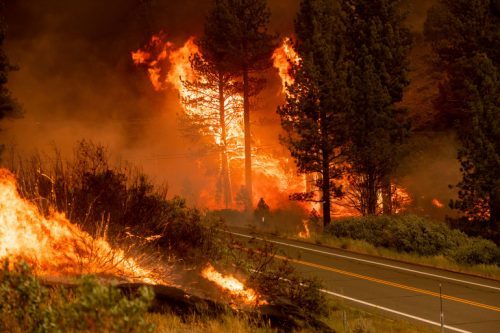LOS ANGELES (AP) — A fierce blaze that consumed a few homes close to Los Angeles might flag that the area is confronting the same perils that have burned Northern California this late spring.
Fire authorities said that the fire in San Bernardino County ejected Wednesday evening, rapidly consumed a few hundred sections of land, and harmed or annihilated no less than twelve homes and storehouses in the lower regions upper east of Los Angeles. Groups utilized digging tools and tractors and mounted an air assault to keep the South Fire from the little networks of Lytle Creek and Scotland. The burst undermined 600 homes and structures alongside power transmission lines, and 1,000 occupants were under departure orders.
By sunset, firefighters seemed to have acquired the advantage, and not many flares were seen. But, be that as it may, the burst was stressing because Southern California’s high fire season commonly comes later in the year when solid, dry Santa Ana twists impact out of the inside and stream toward the coast. Following a couple of cooler days, California’s southern district was relied upon to encounter an arrival of blistering climate into the end of the week that could support fierce blaze hazards. Notwithstanding hazardously dry conditions, the district faces firefighting staffing that is progressively extended slightly, said Lyn Sieliet, a representative for the San Bernardino National Forest.
“A portion of our firemen that we ordinarily have on our woods are chipping away at flames in Northern California, or Idaho and Washington,” she told KTLA-TV. “We don’t have the full staff that we ordinarily do.” The enormous flames in the state and the country were in Northern California, where they have torched little mountain towns and annihilated gigantic areas of kindling dry woods.
The Caldor Fire has annihilated 500 homes since Aug. 14 in the Sierra Nevada southwest of Lake Tahoe, including a large part of the tiny village of Grizzly Flats. It was 12% contained and undermined more than 17,000 designs. Buck Minitch, a fireman with the Pioneer Fire Protection District, was called to the fire lines last week while his significant other escaped their Grizzly Flats home with their two girls, three canines, a cat, and gym bag of garments, the San Jose Mercury News announced.
Hannah Minitch emptied to her folks’ property and the following morning got a text from her better half appearance just a stack where their home once stood. The two sobbed momentarily during a call before he returned to work. “‘We have nothing left here,'” she reviewed him saying. “‘I must go secure what’s left for others.'” Now and again, the breeze-driven fire was consuming 1,000 sections of land (405 hectares) of land each hour. On Wednesday, it was under two dozen miles (37 kilometers) from Lake Tahoe, an elevated get-away and place of interest that rides the California-Nevada state line.
There weren’t any clearings in Tahoe; however, the fire kept on projecting a debilitated yellow pall of smoke over the picturesque area. On the lake’s west shore, the people group of South Lake Tahoe and Tahoe City had the country’s most exceedingly awful air contamination at midmorning Wednesday, as indicated by AirNow, an association of government, state, and nearby air organizations. In the interim, California’s Dixie Fire, the second-biggest in state history at 1,160 square miles (3,004 square kilometers), was consuming just around 65 miles (104 kilometers) toward the north. It was 45% contained. Somewhere in the range of 700 homes were among almost 1,300 structures that have been obliterated.
There was developing worry in the southern Sierra Nevada as the French Fire extended close to Lake Isabella, a mainstream fishing and sailing objective. Around ten networks were under departure orders. The fire has darkened 32 square miles (83 square kilometers) since Aug. 18. Smoke from the flames had fouled air farther south. As a result, the South Coast Air Quality Management District warned Thursday morning for enormous segments of Los Angeles, Riverside, and San Bernardino provinces. Broadly, 92 enormous flames were consuming in 13 fundamentally Western states, as per the National Interagency Fire Center in Boise, Idaho. Environmental change has made the West hotter and drier in the previous 30 years and will keep on making the climate more limited and out of control fires more ruinous, as per researchers.

Fascinating post. I discovered it to be something good to consume. I look forward to additional great posts from this website.